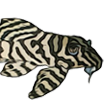https://doi.org/10.1007/s00438-022-01947-6
https://link.springer.com/article/10.10 ... 22-01947-6
Abstract
The catfish belongs to the species-rich family Loricariidae. Loricariids display remarkable traits such as herbivory, a benthic lifestyle, the absence of scales but the presence of dermal bony plates. They are exported as ornamental fish worldwide, with escaped fishes becoming a threat locally. Although genetic and phylogenetic studies are continuously increasing and developmental genetic investigations are underway, no genome assembly has been formally proposed for Loricariidae yet. We report a high-quality genome assembly of Ancistrus triradiatus using long and short reads, and a newly assembled transcriptome. The genome assembly is composed of 9530 scaffolds, including 85.6% of ray-finned fish BUSCOs, and 26,885 predicted protein-coding genes. The genomic GC content is higher than in other catfishes, reflecting the higher metabolism associated with herbivory. The examination of the SCPP gene family indicates that the genes presumably triggering scale loss when absent, are present in the scaleless A. triradiatus, questioning their explanatory role. The analysis of the opsin gene repertoire revealed that gene losses associated to the nocturnal lifestyle of catfishes were not entirely found in A. triradiatus, as the UV-sensitive opsin 5 is present. Finally, most gene family expansions were related to immunity except the gamma crystallin gene family which controls pupil shape and sub-aquatic vision. Thus, the genome of A. triradiatus reveals that fish herbivory may be related to the photic zone habitat, conditions metabolism, photoreception and visual functions. This genome is the first for the catfish suborder Loricarioidei and will serve as backbone for future genetic, developmental and conservation studies.





